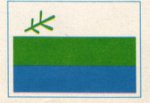
Labrador
|
Labrador |
|
Sit back for a moment and imagine the magnificent geographical and seasonal
diversity of a land whose northern tip is opposite Greenland and southern border is in the
same latitude as London, England. Encompassed within Labrador's vast 294,330 km2 area
(181,580 sq. mi.) you will be stirred by beautiful sheltered, secret places, dazzling,
primitive and untamed nature at its very best. The meandering inland border follows the height of land of the Labrador peninsula, defining the water shed into the Labrador Sea. Much of the interior is plateau. deeply carved by fast rivers ana thundering waterfalls, plunging as much as 91 m (300 ft.) as the water rushes towards the sea. Except for a 56 km (35 mi.) stretch of sand recorded in Viking Sagas nearly 1000 years ago,the 8000 km (5000 mi.) coast line is indented with protected fiords, inlets and bays which are edged with spectacular seascapes and battered cliffs which speak mutely of the awesome forces of glaciers and nature. In northern Labrador the Canadian Shield rim soars into the highest peaks in eastern mainland North America. Made up of the oldest rock known on earth, it also includes deposits of 15 hundred million year old Ramah Chert, a stone so treasured for tools by ancient people it was traded several thousand kilometres from its source shortly after its discovery about 4500 years ago! Cradled within the mountains are small glaciers which calve into intensely blue tarns, or lakes. while further south an impressive mountain range follows a 160 km (100 mi.) long salt water lake into the forested heart of Labrador. To the westward are iron ore and hydro power developments of a magnitude that must be seen to be comprehended. Labrador terminates along the Strait of Belle Isle, a marvelous eco-system which attracted the earliest Europeans to Labrador. Labrador is a storehouse of clues to the earth's formation and predictions of climatic trends through its glaciers. Ancient sites have shed light upon the cultures and relationships of people in transitional forest/tundra and coastal/interior environments and the Basques have provided us with the earliest known Canadian industrial complex and documents. An untamed land, yet Labrador has the longest and richest history of contact in North America!
Northern Ranges The 400 km (250 mi.) long bristly array of
jagged peaks and stunning cliffs that make up northern Labrador and the eastern-most edge
of the canadian Shield are known as the Torngat, Kaumajet and Kiglapait Mountains.
CanoeinglKayaking Many of the rivers which tumble through the Labrador landscape, dropping as much as 3 km (1.8 ml) are ideal for kayaking and white water canoeing. There are described routes for the udjoktok, Notakuanon, Eagle, Little Mecatina and Pinware rivers, taking 7 - 14 days to complete, and many undescribed routes possible, from Labrador west to Nain, North west River or Goose Bay, which can take a month or more to cover. Guided trips, lasting from a few days to a week, are available on rugged rivers cuffing through the Mealy Mountains in a long succession of rapids which drain the inland plateau into Lake Melville. The long coastline offers spectacular opportunities for sea kayaking. |
||||